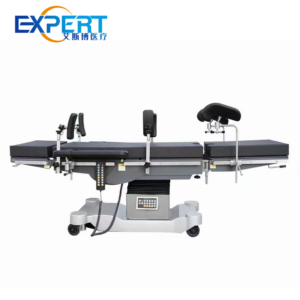Adresse
304, rue Cardinal Nord
Centre Dorchester, MA 02124
Heures de travail
Du lundi au vendredi : 7h - 19h
Week-end : 10h - 17h
In the intricate world of surgical procedures, safety reigns supreme. Operating tables, the foundational platforms upon which these delicate procedures unfold, play a pivotal role in ensuring patient well-being and surgical success. As medical technology continues to advance, operating tables have evolved to incorporate an array of sophisticated safety features that safeguard patients, surgeons, and the entire surgical team. This comprehensive guide delves into the imperative safety features that modern operating tables should possess, unraveling the intricate web of innovation, design, and patient-centered care.
 Safety is the keystone of healthcare, especially within the realm of surgical interventions. Operating tables, as pivotal tools in the surgical environment, have evolved to incorporate a spectrum of safety features that go beyond providing a stable platform. This article delves into the intricate world of safety features within modern operating tables, elucidating their significance in preserving patient well-being and enhancing surgical outcomes.
Safety is the keystone of healthcare, especially within the realm of surgical interventions. Operating tables, as pivotal tools in the surgical environment, have evolved to incorporate a spectrum of safety features that go beyond providing a stable platform. This article delves into the intricate world of safety features within modern operating tables, elucidating their significance in preserving patient well-being and enhancing surgical outcomes.
At the foundation of safety lies stability. Modern operating tables are designed to withstand the demands of intricate procedures, ensuring that the table remains stable and secure throughout. Adequate weight capacity ensures that patients of varying sizes can be accommodated without compromising stability.
Electrically powered operating tables feature fail-safe mechanisms that prevent unexpected movements or adjustments in the event of a power failure. These mechanisms ensure that the table maintains its current position until power is restored, preventing potential risks to patients and surgical procedures.
Auto-braking systems serve as guardians against unintended movements. These systems engage when adjustments are not actively controlled, preventing any accidental shifts in table position. Such features mitigate the risk of harm to patients during critical procedures.
Position locks and indicators enhance precision by securely locking the table in desired positions. Surgeons can confidently focus on the procedure without concerns of unintentional shifts. Visual indicators provide clear feedback, ensuring precise adjustments.
In emergent situations, the ability to swiftly adjust patient positioning is paramount. Emergency Trendelenburg and Reverse Trendelenburg features allow rapid changes in table inclination, aiding patient management during critical phases of surgery.
Operating tables compatible with imaging technologies enable real-time visualization during procedures. Radiolucent materials ensure that X-rays and other imaging modalities can penetrate the table, providing surgeons with clear visual guidance.
Anesthesia screens and safety rails contribute to patient security. These features prevent patients from inadvertently falling off the table during surgery, enhancing patient safety and minimizing the risk of complications.

Battery backup systems provide continuity in power supply, ensuring uninterrupted care during power outages. Redundancy features allow seamless transition between power sources, preventing disruptions to ongoing procedures.
Safety encompasses infection control. Operating tables with antimicrobial surfaces hinder the growth of pathogens, contributing to a sterile surgical environment. Hygiene-conscious designs reduce the risk of post-operative infections.
Safety within the operating room is a collaborative effort. Surgeons, nurses, anesthesiologists, and the entire surgical team contribute to patient well-being. Operating tables with safety features support this collaboration, providing a secure foundation for successful procedures.
Stability ensures a secure platform for surgical procedures, minimizing the risk of table movements that could compromise patient safety.
Electric fail-safe mechanisms prevent unintended movements during power failures. They ensure that the table maintains its position until power is restored.
Auto-braking systems prevent unintended movements by engaging when adjustments are not actively controlled, reducing the risk of harm to patients.
Emergency Trendelenburg and reverse Trendelenburg features allow rapid changes in patient positioning during critical situations, aiding patient management in emergencies.
Imaging-compatible operating tables enable real-time visualization during procedures, providing surgeons with clear guidance and enhancing patient safety.
Safety features within modern operating tables encapsulate a commitment to patient well-being, surgeon confidence, and procedural excellence. From stability and fail-safe mechanisms to compatibility with imaging technologies and infection control measures, these features converge to create a secure and hygienic surgical environment. The evolution of operating table safety features is a testament to the continuous advancement of medical technology and the unwavering dedication to patient-centered care. As innovation continues to reshape the healthcare landscape, operating tables stand as symbols of precision, reliability, and safety, ensuring that the delicate dance of surgery unfolds with the utmost confidence and excellence.
